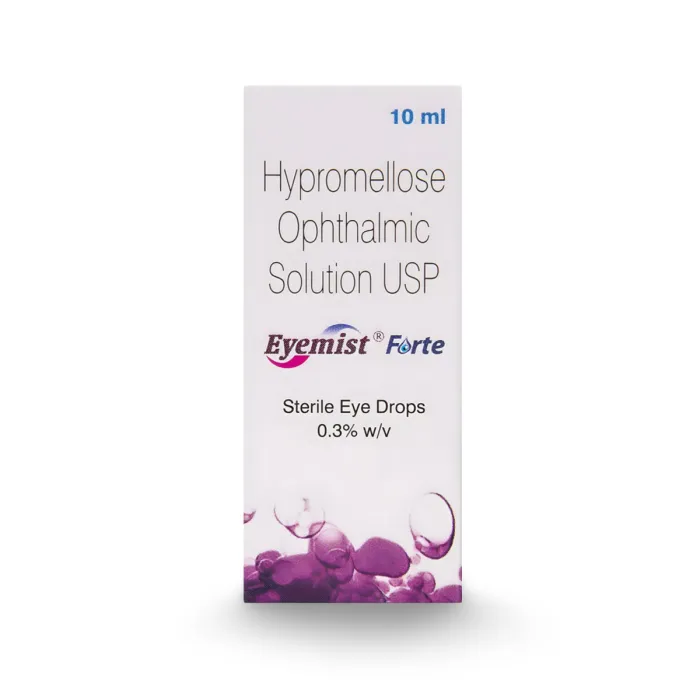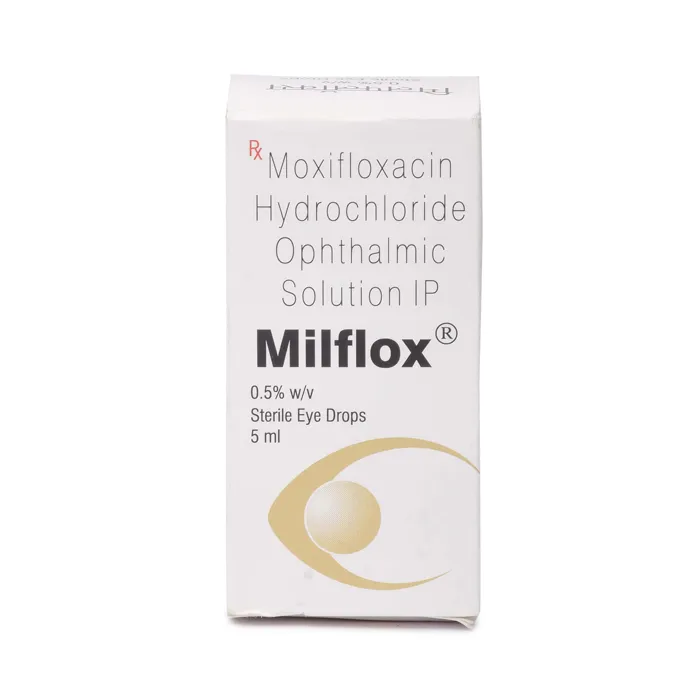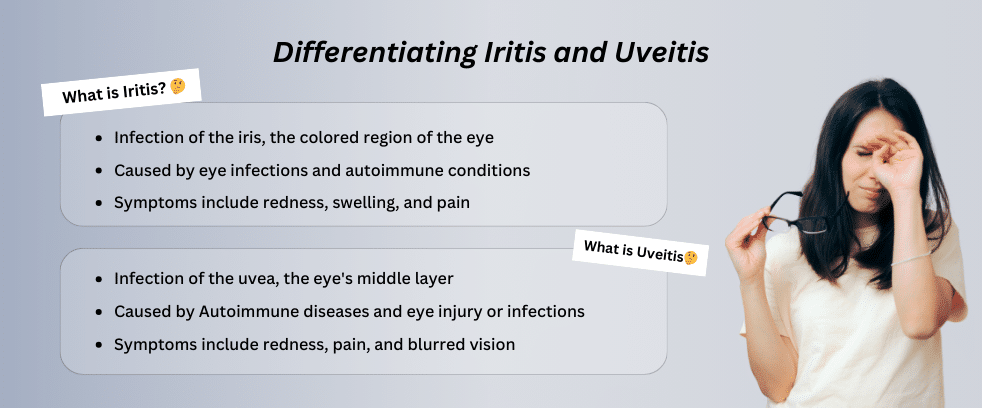When it comes to eye conditions like Iritis and Uveitis, the medical terms can sound a bit confusing. But don’t worry, they’re easier to understand than you may expect! Although the terms appear to be identical, they correspond to different forms of eye inflammation.
Iritis specifically targets the iris, the colored portion of the eye, whereas Uveitis refers to a broader spectrum of inflammation that affects multiple regions of the uvea, including the iris, ciliary body, and choroid.
Understanding the differences between these two conditions is vital for identifying symptoms, understanding causes, and obtaining the right treatment.
Let’s look more closely at every aspect of the topic, “Iritis vs Uveitis.”
Comparing Iritis and Uveitis
Iritis and Uveitis are both conditions characterized by inflammation within the eye, although they affect different areas and are, hence, different.
Now, let’s look further at the detailed comparison between the two.
Save up to 90% on your medicine bills

Eyemist Forte 10 ml

Milflox 0.5% 5 ml

Restasis 0.05% Ophthalmic Emulsion

Pred Forte 10 ml
1. Definition
Uveitis refers to a spectrum of inflammatory disorders affecting the uveal tract, which includes not only the iris but also the ciliary body and choroid. Based on the portion of the eye affected, Uveitis is of four types, namely anterior, middle, posterior, or panuveitis.
- Anterior Uveitis can impact the iris and ciliary body
- Intermediate Uveitis affects the vitreous, which lies behind the iris and ciliary body
- Posterior Uveitis affects the rear of the eye, namely the retina, and choroid
- Panuveitis causes inflammation in all layers of the uvea
On the contrary, Iritis is specifically the inflammation of the iris, the colored portion of the eye that surrounds the pupil. It is sometimes referred to as anterior Uveitis since it affects the front portion of the uveal tract.
2. Occurrence
Uveitis can develop slowly or appear suddenly, and it can recur if underlying conditions aren’t managed.
On the other hand, Iritis typically occurs suddenly, affecting eyesight if not addressed promptly.
3. Symptoms
The symptoms of Uveitis and Iritis are quite similar. Some of them are red eyes, pain, blurred vision, and headaches.
However, Uveitis can cause some additional symptoms, like floaters in vision, particularly in intermediate or posterior cases. These symptoms can vary depending on the affected region.
Iritis leads to more severe pain and might result in a smaller or irregularly shaped pupil. Its symptoms generally appear fast and require immediate medical care to avoid severe consequences, such as Glaucoma or visual loss.
4. Causes
Causes of Iritis and Uveitis frequently coincide.
Several factors can cause Uveitis, including infections (such as herpes or TB), autoimmune diseases, or even side effects from medications. However, the main cause of Uveitis is not known yet.
In many cases, the actual cause of Iritis is also unknown. However, the condition is known to be usually linked to autoimmune diseases, such as ankylosing spondylitis (a type of arthritis causing pain in joints
0, fungal eye infections, and eye injury.

5. Treatment
Treatment for both conditions aims to decrease inflammation and reduce symptoms.
Uveitis and Iritis often involve the same treatment, including corticosteroid eye drops like prednisolone to reduce inflammation and dilating drops to ease the pain. Severe cases may need oral steroids or injections.
However, Uveitis treatment may also include treating any underlying medical conditions causing the inflammation. If the Uveitis is caused by an autoimmune condition, broad-spectrum antibiotics may be prescribed.
Iritis vs Uveitis
The following is a comprehensive comparison table highlighting the key differences between Uveitis and Iritis.
| Feature | Iritis | Uveitis |
|---|---|---|
| Definition | Infection of the iris | Infection of the uvea |
| Type | A specific type of anterior Uveitis | A broader term that comprises anterior, middle, posterior Uveitis, and panuveitis |
| Occurrence | Develop slowly | Develop suddenly |
| Complications | May cause Glaucoma and vision loss if left untreated | Increased risk of retinal injury and irreversible vision loss |
| Symptoms | Eye redness, pain, light sensitivity, blurred vision | Symptoms vary depending on the kind and might include floaters, visual loss, and eye discomfort |
| Treatment | Corticosteroids eye drops, dilating drops, oral steroids | Corticosteroids, immunosuppressants, antibiotics (if related to autoimmune disease) |
| Shop Now | Buy Now | Buy Now |

Frequently Asked Questions
Can Uveitis affect children differently than adults?
Yes, Uveitis affects children differently than adults. Children may be asymptomatic or unable to express their issues, which can lead to delayed diagnosis and treatment. Juvenile Uveitis is chronic and recurring, requiring long-term therapy that differs from those used for adults.
See our Recommendations
Can contact lenses induce Uveitis or Iritis?
Though uncommon, poor contact lens usage or lens-related infections can cause eye inflammation, potentially leading to Uveitis or Iritis.
See our Recommendations
Can Iritis and Uveitis be treated permanently?
No, there is no permanent cure, but both conditions may be controlled with timely treatment. The objective is to reduce inflammation, avoid recurrences, and preserve vision.
See our Recommendations
Can Uveitis or Iritis develop following eye surgery?
Yes, eye surgery can cause postoperative Uveitis or Iritis due to inflammation triggered by the procedure or an immunological reaction.
See our Recommendations
How long does an incident of Iritis or Uveitis usually last?
With proper treatment, an incident of Iritis might last a few weeks, but Uveitis, particularly in chronic instances, can continue for months or even years with repeated flare-ups.
See our Recommendations
Cheap Medicine Shop only refers to credible, authoritative sources for our content. If you’re curious about how we ensure the integrity of our content, we encourage you to read our Content Information Policy.














